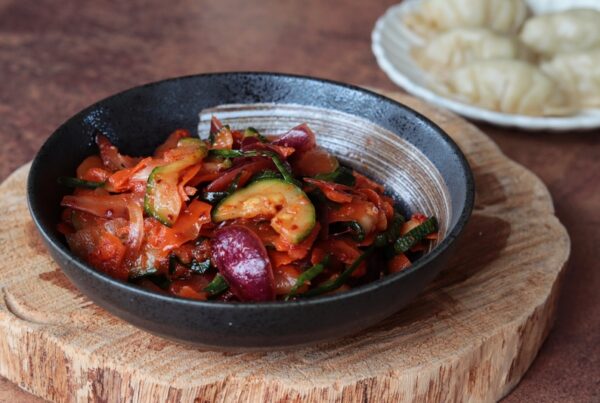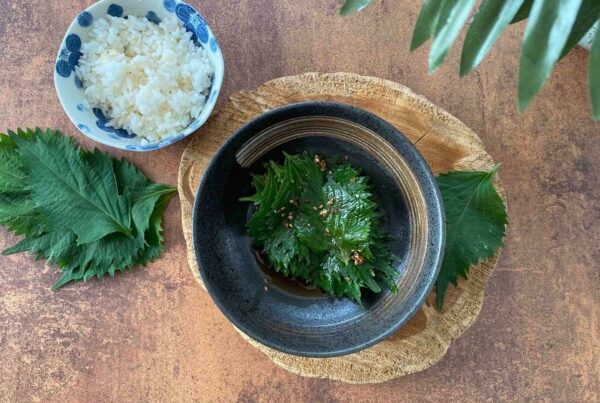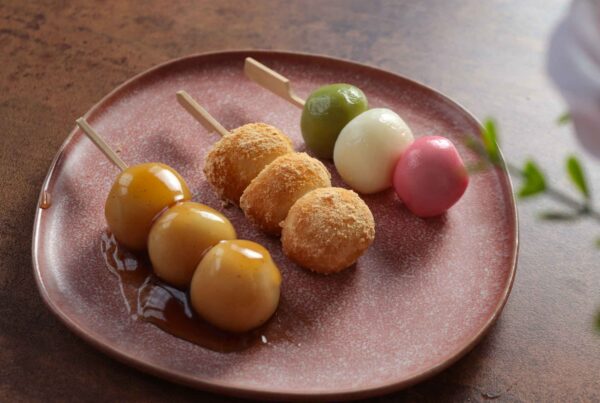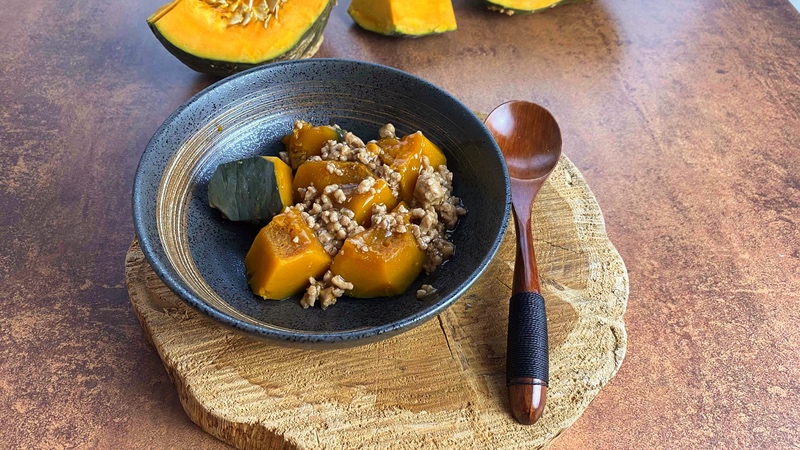
Autumn has arrived, and that means pumpkin recipes! In Japan, this dish is usually not served as a main course but rather as part of several smaller dishes or side dishes. The recipe uses Japanese kabocha squash, but I believe it will work just as well with Hokkaido squash.
What does “soboro” mean?
The word “soboro” can be loosely translated as “crumbled” or “scattered.” In a broader sense, it refers to a dish prepared in a crumbly or loose form. The base can be not only meat but also other ingredients like eggs, fish, or tofu.
This form of preparation is especially popular in households with children because ground meat is easy to eat. Soboro is also often used as a topping for other dishes, added to bento boxes, or used to fill various foods.
Where does kabocha squash come from?
Kabocha is a type of winter squash with dark green skin, subtle stripes, and bright orange, sweet flesh. It is often referred to as Japanese pumpkin, but it actually originates from South America. Portuguese traders are believed to have brought it to Japan in the 16th century. The name “kabocha” comes from the Japanese transcription of the word “Cambodia,” which was the name under which this squash was known in the region of modern-day Cambodia.
In Japan, kabocha quickly became a staple ingredient in the kitchen, mainly due to its ability to be stored for long periods and its resilience to various weather conditions.

What is the difference between Hokkaido and Kabocha squash?
Out of these two squashes, you’re probably more familiar with Hokkaido squash, which is commonly available in stores.
Appearance:
- Hokkaido squash: Its orange skin is thinner and softer, so it doesn’t need to be peeled. It’s round or slightly flattened.
- Kabocha squash: It has dark green skin (sometimes with lighter stripes) that is tougher and thicker, but it is edible and, unless the recipe requires it, it also doesn’t need to be peeled. Its shape is more flattened.
Texture:
- Hokkaido: In my experience, Hokkaido squash is softer and more watery.
- Kabocha: Kabocha has a denser, more buttery, and firmer texture, making it ideal for stews or sturdier dishes.
Flavor:
- Hokkaido: It has a mildly sweet, nutty flavor that is light and pleasant. The flavor isn’t too strong, and it reminds me a lot of sweet potatoes.
- Kabocha: Kabocha is sweeter, and I’d compare its flavor to sweet potatoes as well, but not the regular ones — rather to Japanese sweet potatoes, which are slightly different. In Japan, they even make cakes and desserts with it. For me, Kabocha is definitely the winner in terms of taste.
How is Kabocha squash used in Japanese cuisine?
Kabocha has versatile uses and is incorporated in various ways in Japanese cuisine, both in savory and sweet dishes.
- Tempura: It is prepared as tempura along with other vegetables.
- Miso soup: Kabocha can be added to miso soup. Essentially, almost any seasonal vegetable can be used in miso soup.
- Nimono: Kabocha is often simmered in a savory broth made from dashi, soy sauce, and mirin, absorbing the flavors and developing a soft texture.
- Soups: While creamy soups are not typical in Japanese cuisine, a few do exist. For example, thick corn pottage is very popular, and Kabocha’s texture is perfect for these types of soups.
- Curry: It can be added to Japanese curry, where its sweetness contrasts nicely with the spicy sauce.
- Desserts: Kabocha is also used in cakes, puddings, and pastries due to its naturally sweet flavor.
Can Kabocha squash be grown outside of Japan?
Yes, it can. Growing kabocha is not difficult. The seeds are sown in the spring after the last frost. It needs plenty of sunlight and warmth, so it should be planted in a sunny spot. Kabocha is quite hardy and doesn’t require much care. However, if you are growing other types of squash, they can cross-pollinate over time. Especially if you save kabocha seeds and plant them year after year, the squash may change with each season, becoming a mix of kabocha and the other variety.
The fruits ripen during the summer and are harvested in the fall when the skins are hard and dark green. If stored properly, kabocha can last for several months, making it a great ingredient for the winter months.
How to store Kabocha squash?
Whole squash:
- Store in a cool, dry place: Kabocha should be kept in a dry and cool area with a temperature around 10–15°C (50–59°F). An ideal place would be a pantry, cellar, or a cool room. Avoid storing it in overly humid environments.
- Ventilation is important: Ensure that air circulates around the squash. Don’t place it directly on the ground or on a hard surface—use a wooden stand or a wicker basket to allow it to “breathe.”
- Shelf life: In ideal conditions, a whole kabocha can last 1 to 3 months. Its tough skin protects it from drying out or rotting.
Cut or sliced squash:
- Refrigeration: If the kabocha is already cut or sliced, it should be wrapped in plastic wrap or placed in an airtight container and stored in the refrigerator. In this form, it will last 4–5 days.
- Preventing oxidation: Once the squash is cut, you can place a piece of parchment paper or plastic wrap over the cut surfaces to prevent it from oxidizing and drying out.
How to cut Kabocha squash?
Raw Kabocha squash can be quite hard, so you need to be very careful when cutting it. If you want to pay attention to aesthetics, you can use the Japanese technique called mentori. In Japan, there’s a specific term for nearly every type of ingredient cutting method, which could easily fill an entire chapter on its own.
Mentori involves trimming the sharp edges of the squash pieces to create smoother, rounded corners. This technique not only improves the appearance but also helps prevent the squash from breaking apart during cooking.
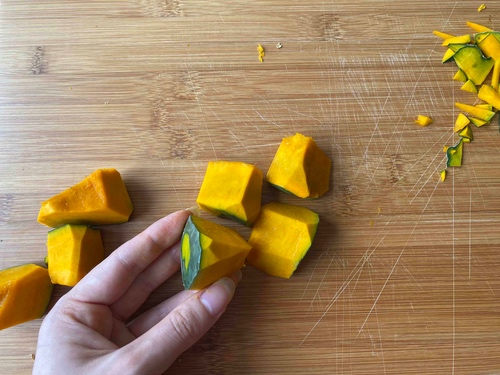
Mentori is a technique where the edges of vegetables (especially harder ones like squash, radish, or potatoes) are gently trimmed or rounded. This process serves several purposes:
- Prevents vegetables from cracking during cooking: Rounded edges reduce the pressure that might otherwise cause cracking when simmering.
- Enhances the visual presentation: The vegetables look smoother and more “elegant.” Japanese cuisine is known for its emphasis on the visual appeal of food.
- Improves flavor absorption: Rounded edges help the vegetable absorb broths or sauces more evenly, leading to a more balanced flavor.
What is an Otoshibuta?
In the recipe and video, you might notice that I use what appears to be an extra lid inside the pot. This is a traditional Japanese kitchen tool called an otoshibuta, used for simmering dishes. It is placed directly on top of the food in the pot or pan.

Why is Otoshibuta used?
- Even cooking: Since the otoshibuta sits directly on the food, it ensures that heat and liquids are evenly distributed, preventing uneven cooking.
- Keeps food intact: The gentle pressure of the otoshibuta helps prevent the food from moving or bumping into each other during cooking, which reduces the chance of delicate ingredients like tofu or fish breaking apart.
- Reduces evaporation: The otoshibuta helps minimize liquid loss, keeping sauces thick and concentrated.
While not essential for preparing this dish, without it, your liquid might evaporate more quickly, and you may need 50–100 ml more water. You can also create a DIY alternative, like I did in a recipe for sweet adzuki bean soup. Simply fold aluminum foil into a circle, poke a few holes to allow steam to escape, and optionally place a small plate on top to weigh it down slightly.
Interested to discover more about Japanese cooking? Let’s keep in touch on Instagram, Facebook, and Pinterest.
Sharing is caring:
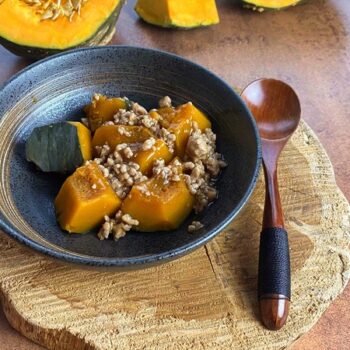
Kabocha soboro (Squash with ground meat)
Video
Ingredients
- 300 g kabocha
- 350 ml water
- 1 tsp dashi powder
- 8 g kombu
- 1 tbsp mirin
- 1 tbsp soy sauce
- 1.5 tbsp sugar
- Fresh ginger (grated)
For sauce:
- 150 g ground meat (I used pork)
- 2 tsp saké
- 2 tsp soy sauce
- 1 a level tbsp starch (corn or potato)
Instructions
- First, we clean and chop the squash. Kabocha squash can be quite hard, so we need to be careful when cutting it. Any protrusions should be trimmed off, as they won't cook properly.

- Cut the squash into pieces roughly like this. You can round off the edges like this, which is a Japanese cutting technique to soften sharp corners.

- In a pot, combine water, dashi powder, kombu seaweed, and the chopped squash.
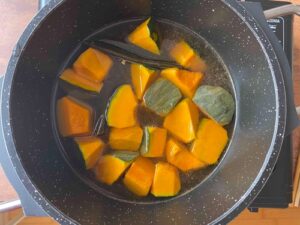
- If you have an otoshibuta, place it on top. Cover with a lid and bring to a boil. As you can see in the previous step, the squash is not completely submerged, but the otoshibuta helps prevent excess evaporation, so this amount of water is sufficient.
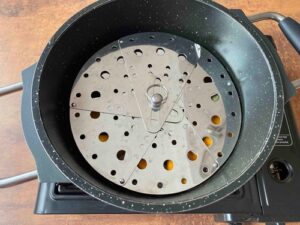
- Once the water with the squash begins to boil, add sugar and mirin, and simmer on low heat for 10 minutes. Then add soy sauce and continue cooking for another 5 minutes. After that, turn off the heat and set aside the cooked squash. We will need this "broth" for the sauce.
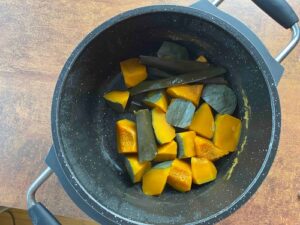
For the sauce:
- Heat a pot and add the ground meat. I don’t add any oil.
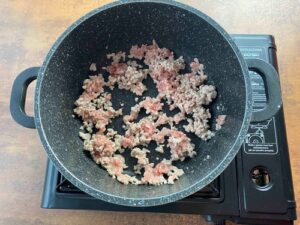
- Add sake and soy sauce.
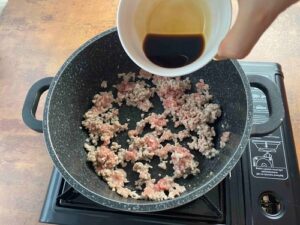
- While continuously stirring, sauté over medium heat, breaking the meat into small pieces.
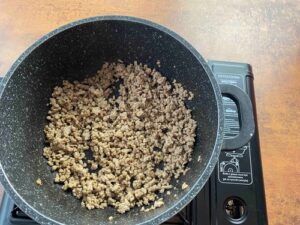
- Once the meat is cooked, add grated fresh ginger (to your taste, or you can omit it entirely if you’re not a fan of ginger) and pour in the broth from the cooked squash.
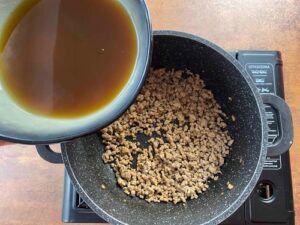
- In a small bowl, dissolve starch in a little water. I used one level tablespoon, but this can vary depending on how much broth you have left. Make sure the starch is fully dissolved, and as you pour it into the meat, stir the sauce quickly to ensure the starch is well mixed and no lumps remain.

- You can garnish the dish with finely chopped green onions on top.

Itadakimas!

